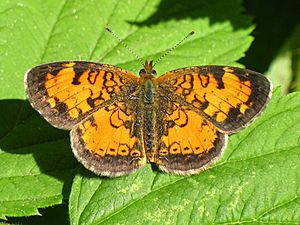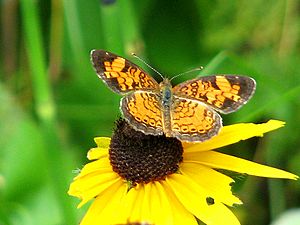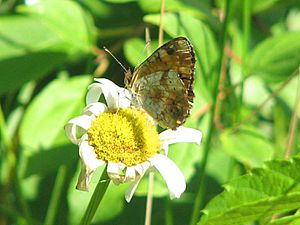Northern crescent facts for kids
Quick facts for kids Northern crescent |
|
|---|---|
 |
|
| Scientific classification | |
| Kingdom: | |
| Phylum: | |
| Class: | |
| Order: | |
| Family: | |
| Genus: |
Phyciodes
|
| Species: |
P. cocyta
|
| Binomial name | |
| Phyciodes cocyta (Cramer, [1777])
|
|
| Synonyms | |
|
|
The northern crescent (scientific name: Phyciodes cocyta) is a beautiful butterfly. It belongs to the Nymphalidae family, also known as the brush-footed butterflies. You can find this butterfly flying around in many parts of North America.
Contents
All About the Northern Crescent Butterfly
The northern crescent is a type of insect that goes through a complete metamorphosis. This means it changes from an egg to a larva (caterpillar), then to a pupa (chrysalis), and finally into an adult butterfly.
What Does It Look Like?
This butterfly is fairly small. Its wingspan (the distance from one wingtip to the other) is usually between 32 and 38 millimeters. That's about 1.2 to 1.5 inches! The northern crescent gets its name from a crescent-shaped mark. This mark is often found on the underside of its hindwings. The butterfly has a mix of orange, black, and brown patterns on its wings.
Where Does It Live?
The northern crescent butterfly lives in the Nearctic realm. This means it's found across a large part of North America. You can often spot them flying during the summer months. They usually fly from June to July. The exact time can change a bit depending on where they are.
What Do They Eat?
Like all butterflies, the northern crescent has different diets. These diets depend on its stage of life. As a larva, or caterpillar, it eats plants from the Asteraceae family. This family includes plants like sunflowers and daisies. Adult butterflies drink nectar from flowers. They use their long, straw-like mouthpart called a proboscis to sip the sweet liquid.
Similar Butterflies
It can sometimes be tricky to tell the northern crescent apart from other similar butterflies. Here are two other crescent butterflies you might see:
- Phyciodes batesii – This is the tawny crescent.
- Phyciodes tharos – This is the pearl crescent.
Scientists look closely at the patterns on their wings to tell them apart.



